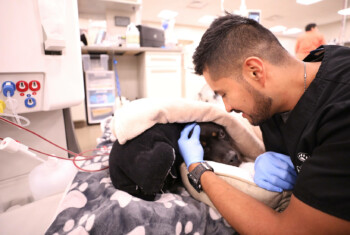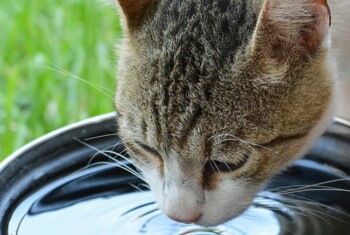What is hyperadrenocorticism?
Hyperadrenocorticism (Cushing’s disease) is a clinical condition that dogs can develop if they have excess concentrations of cortisol in the body.
In some cases, a tumor in the pituitary gland can result in excessive cortisol throughout the body, resulting in “pituitary dependent” Cushing’s disease.
Clinical signs and symptoms
Dogs with hyperadrenocorticism will most commonly exhibit signs like:
- Excessive urination
- Excessive drinking
- Increased appetite
- Hair loss
- Muscle weakness
- A “potbellied” appearance
- Panting
- Thin skin
- Lethargy
Almost all dogs with Cushing’s disease have at least one of these signs, but it would be uncommon to have all of them. Some of these symptoms, such as excessive drinking and urination, mimic other diseases like diabetes, kidney disease or urinary tract infections. Because of this, your pet’s veterinarian will attempt to rule out other conditions as part of the diagnostic process for hyperadrenocorticism.
Causes
Cushing’s disease typically strikes middle-aged to older dogs. It is caused by having excess steroids in the body. Most frequently, this is due to a benign tumor of the pituitary gland.
In about 15% of cases, hyperadrenocorticism is caused by a tumor in one of the adrenal glands.
Dogs with this condition are at risk for blood clots, kidney damage, high blood pressure and diabetes, so it is important to take your pet to a veterinarian as soon as you notice them behaving out of the ordinary or exhibiting any of the common signs of hyperadrenocorticism.
Getting a diagnosis

Cushing’s disease can only be diagnosed using blood tests. These tests may include:
- Complete blood count (CBC)
- Full chemistry panel
- Urinalysis
- Urine culture
- Adrenal function tests such as low-dose and high-dose dexamethasone suppression and possibly adrenocorticotropic hormone (ACTH) stimulation
These tests, combined with the physical signs, will help a veterinarian diagnose Cushing’s disease. False positive adrenal function tests are common when another disease with similar clinical signs is present.
Ultrasound is occasionally helpful in diagnosing Cushing’s disease, but it is extremely valuable to help rule out other reasons for the patient’s clinical signs, particularly because other diseases may present similarly, including:
- Bladder stones
- Urinary tract infections
- Tumors of the liver or spleen
- Chronic inflammatory liver disease
- Gall bladder disease
- Gastrointestinal disease
Adrenal enlargement may be difficult to identify through ultrasound because of patient movement or interference from gas in the overlying intestine. In general, ultrasound is an insensitive indicator of adrenal disease. Magnetic resonance imaging (MRI) is the preferred diagnostic imaging procedure to evaluate the adrenal glands, but it is more costly.
Treatment
If your dog is diagnosed with Cushing’s, your veterinarian can prescribe medication to control the condition. The medication must be continued throughout your dog’s life, although the dose may need to be adjusted from time to time.
There are currently two main drugs that are used to treat Cushing’s disease in dogs: mitotane and trilostane.
Mitotane can destroy the cortisol-producing cells of the adrenal gland in dogs. Trilostane also decreases the amount of cortisol produced by the adrenal glands but does so by inhibiting specific steps in cortisol production. Both mitotane and trilostane can effectively treat and control the signs of Cushing’s disease.

Mitotane
Mitotane must be given in a controlled manner for an “induction” period. The medication should be given immediately after eating as the drug is absorbed best from a stomach containing food. This will also help decrease the chance of your dog having an upset stomach.
You may also be asked to give the drug in a divided dose – half in the morning and the other half in the evening – with meals. You may notice a decrease in appetite during the induction phase.
If your dog stops eating or drinking, contact your veterinarian immediately and stop the medication. If vomiting or diarrhea develops, you should also contact your veterinarian and stop the medication.
After the induction phase, you will be asked to bring your dog to the hospital for an ACTH stimulation test. This test “stimulates” the adrenal gland. If the mitotane has done its job, the adrenal gland will not overreact to the stimulation. The results of this test will help your veterinarian determine a starting maintenance dose of mitotane for your dog. This test can be done on an outpatient basis.
Trilostane
Trilostane does not require an induction phase like mitotane does. However, small adjustments to the dose of trilostane are often needed early in treatment, and over the life of your dog, other changes may be made based on routine monitoring of blood tests and how well the clinical signs of Cushing’s disease are being controlled. Trilostane may also need to be administered up to twice per day for the rest of your dog’s life.
Either medication will be continued for the rest of your dog’s life, though the dose may need to be periodically readjusted. Recheck ACTH stimulation tests initially need to be done as often as monthly until control of excessive cortisol production is achieved. Thereafter, testing will be needed at regular intervals determined by the control achieved with your pet. Close observation and frequent recheck appointments can only help in the long-term management of your pet.
Potential medication side effects
The medication for Cushing’s disease is very effective when used in the proper dosage. Like insulin in a patient with diabetes, however, the wrong dose can cause side effects ranging from mild to severe.
If monitored frequently with blood tests, it is very unusual to see any adverse reactions; however, the reactions to be aware of, in order of which you would notice, include:
- Decreased appetite, picky eating, eating more slowly (leaving food, taking longer to eat)
- Gastrointestinal upset such as vomiting or diarrhea
- Weakness, lethargy or depression
If you notice these symptoms, please discontinue the medication and call your veterinarian. With proper and careful regulation, the incidence of these side effects is typically less than 1%.
Prognosis
Cushing’s disease can be a challenging condition to manage due to medication costs and the need for frequent blood monitoring. With good follow-up and periodic monitoring of adrenal function, however, the prognosis is good.
Pets who do not receive adequate follow-up and monitoring often have relapses of the disease, and severe illness or death may occur because of complications resulting from poorly regulated hyperadrenocorticism.


